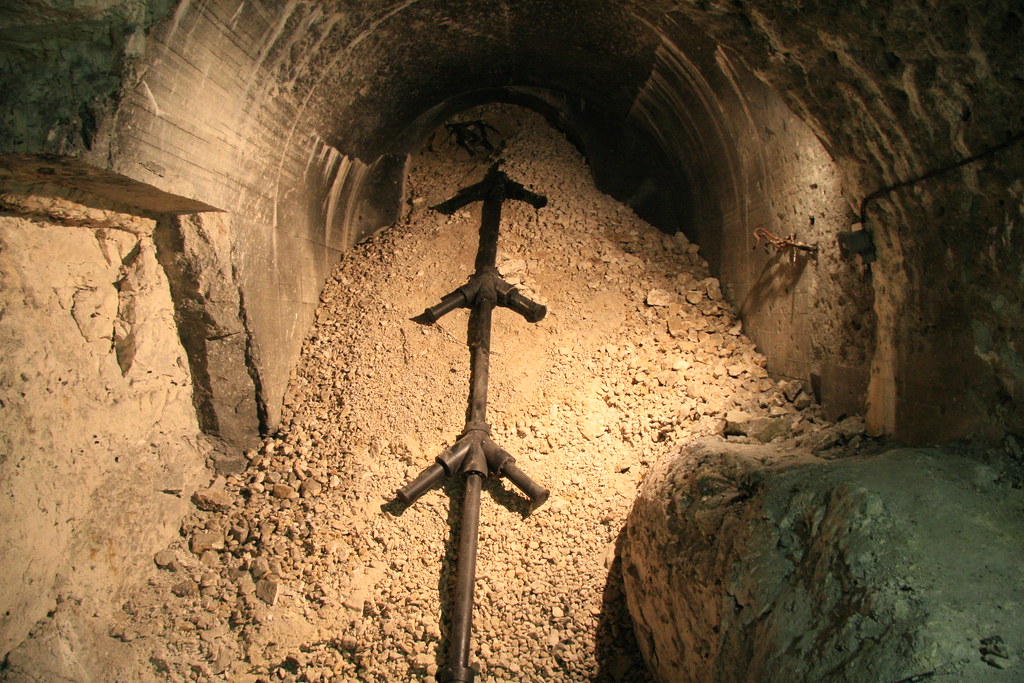About twenty kilometers from the city of Boulogne-sur-Mer, near the hamlet of Mimoyecques, in northern France, lies a once-secret underground Nazi base. Dug out under the limestone hills, the sprawling complex consisted of a network of tunnels linked to five inclined shafts in which Hitler planned to install more than two dozen superguns, called the V-3, all targeted towards London, 165 km away. The base was never completed, and its purpose of attacking London never realized. Had it been successful, the attack on London would have constituted—in Winston Churchill’s own words— "the most devastating attack of all".
Late in the war, the Germans began developing a series of "retaliatory weapons", called Vergeltungswaffen, that were exceptionally long-range for the time. The first in the series, the V-1, also known as the “flying bomb”, was the precursor to the cruise missile. The V-2 was the world's first long-range guided ballistic missile. The third in the series, the V-3, was supposed to be a supergun with a long firing range.
Prototype of a V-3 cannon at Laatzig, Germany (now Poland) in 1942.
The V-3 was basically a cannon with a long barrel, over 100 meters in length, with multiple charges placed along the barrel's length. The charges were timed to fire as soon as the projectile passed them in order to provide an additional boost to the shells. The gun was still in its prototype stages, but Hitler was eager to have a battery of V-3 guns in France to supplement the planned V-1 and V-2 missile campaigns against London.
To reach England, it was calculated that the barrel of the gun had to be 127 meters long, and because of its size, the gun had to be deployed from a fixed site. The ideal location, it was decided, would be a hill with a rock core into which inclined drifts could be tunneled to support the barrels. A search along the coast of the English Channel across Britain yielded a site near the hamlet of Mimoyecques, 165 km from London. The site had a small hill made primarily of chalk that was easy to tunnel. The chalk also extends several hundred meters below the surface, providing ample space for a deep underground base.
Construction on the gun battery began in September 1943. The initial layout comprised two parallel facilities a kilometer apart, each with five drifts holding five V-3 gun tubes each, for a total of 25 guns. The entire battery would have been able to fire up to 10 shells a minute, or 600 rounds every hour. Both facilities were served by an underground railway tunnel and underground ammunition storage galleries.
The Allied Forces were completely unaware of the V-3 project, but they knew something was afoot at Mimoyecques. Aerial reconnaissance photograph revealed railway lines leading into the tunnels, and large-scale activity around them. The Allies concluded that the site was a launch pad for more V-2 rockets, and needed to be urgently put out of commission.
The Allied air forces carried out several bombing raids on Mimoyecques between November 1943 and June 1944 but caused little damage. Then on July 1944, the Royal Air Force dropped several ground-penetrating Tallboy bombs collapsing the tunnels and entombing some 300 forced slave laborers underground. The Allies continued bombing the site until approaching Canadian forces from the Normandy landings captured what was left of the base on September 1944.
After the war ended, Churchill ordered the site to be demolished so that it could never be used again.
In 1969, a local farmer excavated a small section of the tunnel and began using it as a mushroom farm. Later, in 1984, he cleared out more of the tunnels and opened a museum under the name “Forteresse de Mimoyecques.”
Reconstructed view of the installation as originally planned

One of the concrete slabs through which the V-3 guns would have been fired. It was demolished in May 1945 by the Royal Engineers.
A multi-charge cannon by Haskell (1892), based on which the V-3 was designed.
Entrance to the railway tunnel at the Mimoyecques eastern site. Photo credit: Gilles Messian/Flickr
Inside the tunnel, which is now open to visitors. Photo credit: Nigel S/Flickr
Replica of V-3 gun barrels at Mimoyecques. Photo credit: A J Veitch/Flickr


















Comments
Post a Comment